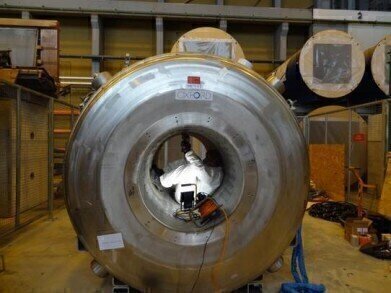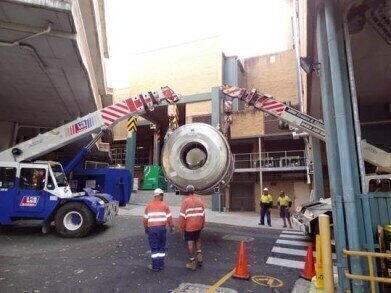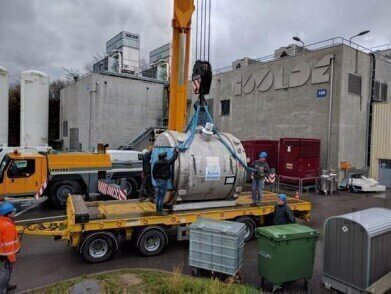-
 MRI magnet being cleaned by STFC apprentice (Credit: Paul Morrall)
MRI magnet being cleaned by STFC apprentice (Credit: Paul Morrall) -
 MRI magnet being moved out of the hospital in Brisbane (Credit: Paul Morrall)
MRI magnet being moved out of the hospital in Brisbane (Credit: Paul Morrall) -
 MRI magnet being delivered to Isolde CERN (Credit: Karl Johnston)
MRI magnet being delivered to Isolde CERN (Credit: Karl Johnston)
News & Views
MRI Scanner Modified to Study the Stuff of Stars
Mar 31 2017
After spending 15 years scanning patients at an Australian hospital, an unwanted MRI machine has been given a new lease of life at the world’s biggest science experiment as a scanner of the material that makes up exploding stars.
A team of UK scientists and engineers reclaimed the superconducting magnet from an old MRI scanner, before modifying it for use at CERN to help us better understand how the Universe works. This project cost about £130,000 – whereas producing a bespoke magnet from scratch would have cost £1million or more.
After reaching the end of its life at the Brisbane hospital, the magnet undertook an epic journey round the world as it was shipped to CERN, the home of the Large Hadron Collider, in Switzerland. A small team from the UK’s Science and Technology Facilities Council (STFC), including two young apprentices from STFC’s Daresbury Laboratory, worked to strip and reconfigure the magnet ready for use on the ISOLDE instrument. In early 2017 the magnet was ready for final testing and installation. With help from the CERN cryogenics team, the magnet was cooled using liquid helium before being successfully re-energised to prove that it was ready to work again as a superconducting magnet in its new role. Once fully operational the magnet will perform a vital role at ISOLDE, a nuclear physics facility which provides both low-energy and high energy re-accelerated radioactive beams to observe the properties of atomic nuclei.
Professor Robert Page from the Physics department at the University of Liverpool, who leads the international collaboration that will exploit the magnet, said: "The ISOL-SRS project is designing and constructing spectrometers to explore subtle features of the forces that bind atomic nuclei and nuclear reactions thought to occur in stellar explosions.
“This ex-MRI magnet is a vital component of the spectrometer to be exploited at CERN's world-leading HIE-ISOLDE facility and following its successful recommissioning we are now in a position to embark on this new and exciting science programme with our collaborators from institutions across the UK, Europe and Argonne National Laboratory in the USA."
The purchase of the ex-MRI magnet and the cost of reconfiguring it for use on the ISOLDE experiment were co-funded by STFC, the University of Liverpool, the University of Leuven and the University of Manchester. It will contain advanced silicon detectors that are being built by a UK-led team as part of the ISOL-SRS project.
Digital Edition
Lab Asia 31.2 April 2024
April 2024
In This Edition Chromatography Articles - Approaches to troubleshooting an SPE method for the analysis of oligonucleotides (pt i) - High-precision liquid flow processes demand full fluidic c...
View all digital editions
Events
Apr 28 2024 Montreal, Quebec, Canada
May 05 2024 Seville, Spain
InformEx Zone at CPhl North America
May 07 2024 Pennsylvania, PA, USA
May 14 2024 Oklahoma City, OK, USA
May 15 2024 Birmingham, UK

















